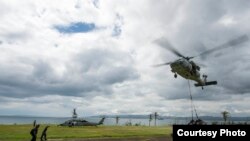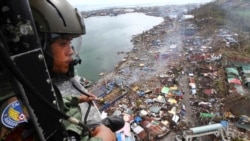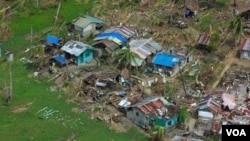MANILA —
In the Philippines, the World Food Program says a quarter of the people in dire need of food in the typhoon-battered central parts of the country still have not received it. Eleven days after the storm hit, the government says some 5,600 people are dead or missing (3,982 people killed, 1,602 missing).
Officials and international aid groups have struggled with the challenge of delivering food to remote and inaccessible parts of the country.
On Tuesday, WFP Executive Director Ertharin Cousin said agencies have so far distributed emergency packages to 1.9 million people who have had no access to food since Super Typhoon Haiyan struck on November 8. But that still leaves another 600,000 who have had nothing to eat for the last 11 days.
Cousin told reporters in Manila the archipelagic nature of the Philippines has made it difficult to reach everyone. She said aid workers are using helicopters, planes, boats and trucks to push the food packs out.
“This is a relief effort where there are so many remote communities, that the challenges of getting into every community have been massive,” Cousin said.
The aid effort has been challenged by the Philippines spread-out geography, as well as damaged roads and airstrips. Government groups and aid agencies had been contending with power outages, no communications and impassable roads for days.
These issues have been partially addressed in a majority of the affected provinces but some provinces still have no power and very poor cellular phone signals.
U.S. and Philippines forces have been delivering food by landing helicopters in inaccessible places and delivering food by hand.
WATCH: Related video from VOA's Steve Herman
Cousin said some have suggested relying more on air drops. But that kind of delivery method would not be as effective, she said.
“We know that while just dropping food would really look good on camera, those who are most in need of food would not receive it. Those are children, those are women, those are seniors. Those are the disabled,” Cousin said.
Cousin reiterated that the World Food Program could not do its work alone. She said the agency is working with the government and other international humanitarian groups. According to Cousin, as more of these agencies arrive in the hard-hit areas, more people will be reached.
Meanwhile, U.S. aid efforts continue:
The latest photos from Eastern Samar:
Officials and international aid groups have struggled with the challenge of delivering food to remote and inaccessible parts of the country.
On Tuesday, WFP Executive Director Ertharin Cousin said agencies have so far distributed emergency packages to 1.9 million people who have had no access to food since Super Typhoon Haiyan struck on November 8. But that still leaves another 600,000 who have had nothing to eat for the last 11 days.
Some Organizations Helping Typhoon Victims
Some Organizations Helping Typhoon Victims“This is a relief effort where there are so many remote communities, that the challenges of getting into every community have been massive,” Cousin said.
The aid effort has been challenged by the Philippines spread-out geography, as well as damaged roads and airstrips. Government groups and aid agencies had been contending with power outages, no communications and impassable roads for days.
These issues have been partially addressed in a majority of the affected provinces but some provinces still have no power and very poor cellular phone signals.
U.S. and Philippines forces have been delivering food by landing helicopters in inaccessible places and delivering food by hand.
WATCH: Related video from VOA's Steve Herman
Cousin said some have suggested relying more on air drops. But that kind of delivery method would not be as effective, she said.
“We know that while just dropping food would really look good on camera, those who are most in need of food would not receive it. Those are children, those are women, those are seniors. Those are the disabled,” Cousin said.
Cousin reiterated that the World Food Program could not do its work alone. She said the agency is working with the government and other international humanitarian groups. According to Cousin, as more of these agencies arrive in the hard-hit areas, more people will be reached.
Meanwhile, U.S. aid efforts continue:
The latest photos from Eastern Samar:













